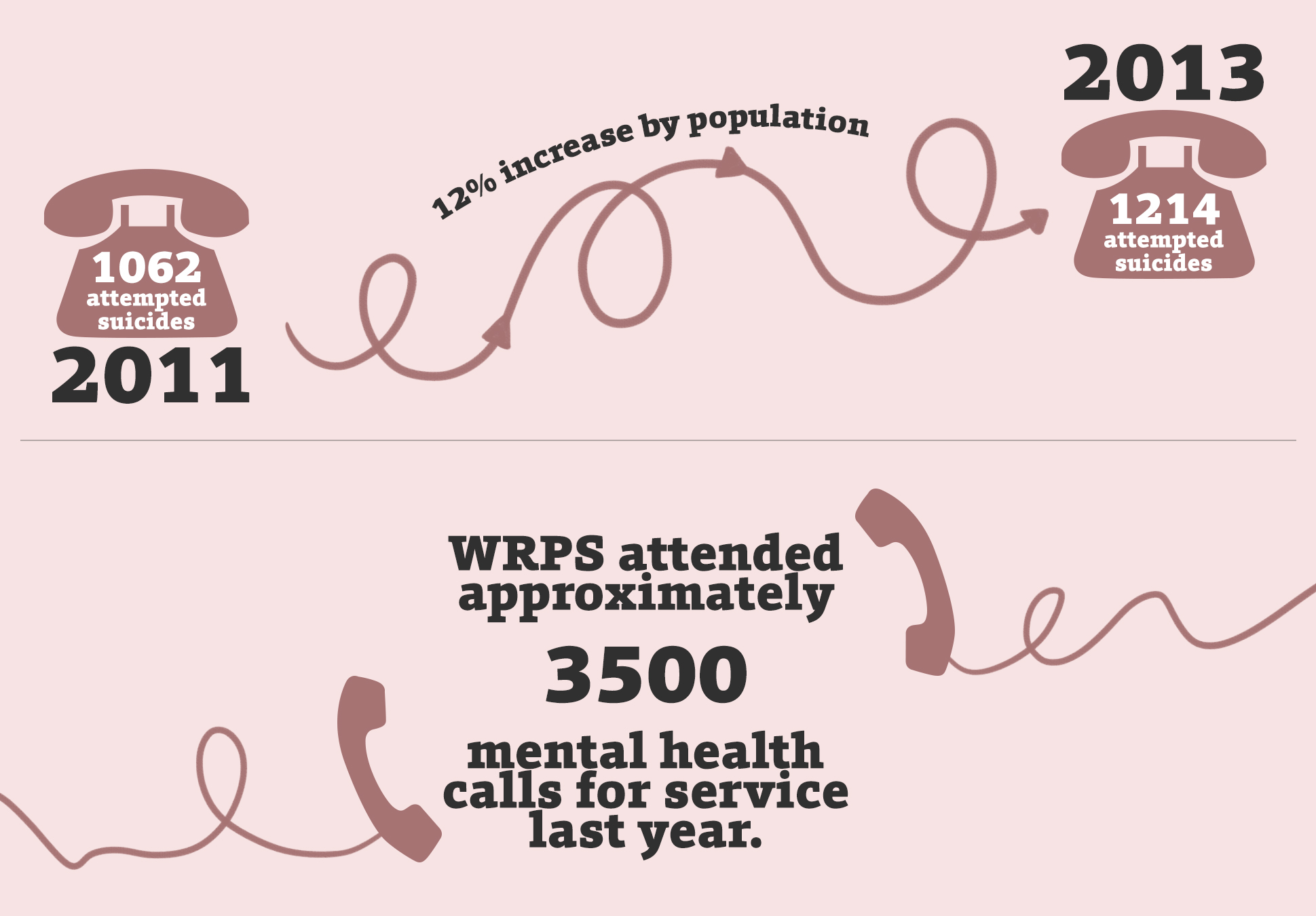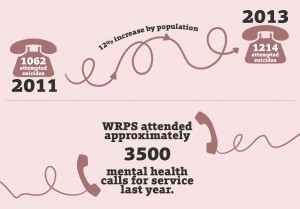Suicides surge in Waterloo – region seeks to improve resources

Awareness is the mantra of community stakeholders in the wake of statistics which revealed a 57 per cent increase in suicides by population in Waterloo Region between 2008 and 2013.

Awareness is the mantra of community stakeholders in the wake of statistics which revealed a 57 per cent increase in suicides by population in Waterloo Region between 2008 and 2013.
The provincial increase was 14 per cent.
According to Bryan Larkin, chief of the Waterloo Regional Police Service, they have been seeing a greater demand for police support around mental health calls for service. He believes this increase speaks to a need for greater awareness around suicide and mental health as a whole.
“I think from a broader perspective with our community, we need to say here are some things that you can do — because it’s a very private discussion, often it’s a very difficult discussion,” he continued. “How do we raise awareness and how do we build some concepts.”
In 2013, WRPS responded to 1,214 attempted suicides, as compared to 1,062 in 2011. This amounts to a 12 per cent increase by population. WRPS attended approximately 3,500 mental health calls for service last year.
But Tana Nash, executive director of the Waterloo Region Suicide Prevention Council, said there could be more than meets the eye to this increase in statistics surrounding suicides in the region. For one, the increase could be the result of better tracking: more deaths are being tracked as suicides where, in the past, they would have been considered accidents.
“Are we just doing a better job of breaking down stigma, where you have family members and professionals that are feeling more comfortable in saying, ‘that was suicide,’” Nash said.
She also noted police only began tracking suicide attempt calls around five years ago, making it difficult to know how current numbers hold up to the past.
“Also, especially with suicide attempt calls, that could be a positive — does that mean more people are reaching out for help, or they’re even calling on behalf of a friend or a family member that they are concerned about because they want to make sure they get the help they want?”
Larkin explained that trying to pinpoint a cause behind the increase can be difficult.
“It varies — there’s not any particular area of the region that isn’t impacted by [suicide],” he said.
“I think it’s one of those things where our ongoing discussion hopefully turns a lens to ‘why is this happening?’ Because I don’t think anybody has a definitive answer.”
Scott Grant, coordinator of Skills for Safer Living at the Self Help Alliance, echoed Larkin’s sentiment that it can be difficult to identify a cause for many suicides.
“The thing is, you are working with people and the thing with people is it’s not always cut and dry,” Grant said. “Everyone may experience it a little bit differently.”
He continued that those who are accessing their Skills for Safer Living are usually in a lot of psychological pain when they first come in.
For them, death has become the way to end their pain. In the meantime, both WRPS and the Suicide Prevention Council are continuing to take steps to prevent suicide and increase a dialogue around mental health.
WRPS will be launching an internal program called Road to Mental Awareness in January. While the program is aimed at ensuring the WRPS members are emotionally healthy, this will create ripples.
“We think that our members will get a lot of firsthand knowledge, a lot of understanding of the issues and then be able to translate that into the community,” Larkin said.
The council’s focus in the coming years is going to be on men in the workplace, as the largest demographic for suicides are among middle-aged men.
Nash mentioned the emphasis workplaces put on physical health due to the dangerous working conditions of the past.
“Now it’s time to pay attention to the emotional mental health,” she continued. “Imagine if we put the same energy in and if workplaces had somebody trained in suicide prevention and mental health first aid the difference we could make.”
However mental health issues aren’t selective and the reality of suicide is present in many demographics. According to the Canadian Mental Health Association, suicide is among the leading causes of death in 15 to 24-year-old Canadians. As well, approximately 10 to 20 per cent of Canadian youth are affected by a mental illness or disorder.
“We’ve done a lot of work over the last few years to try and improve mental health services for students,” said Karen Ostrander, director of the Student Wellness Centre at Wilfrid Laurier University.
“Certainly, our own numbers, we’re seeing a lot more people accessing services. I think that’s a very positive thing.”
At Laurier, faculty and staff are able to take a course in Mental Health First Aid, which enables them to identify mental health issues and gives them tools to be the first support for individuals in need.
Additionally, all residence dons, other student leaders, faculty and staff have been trained through the safeTALK program to be able to identify signs when an individual is having suicidal thoughts.
By October, a Laurier staff member will have completed their Applied Suicide Intervention Skills Training, which allows them to be the next site of support for an individual who is having thoughts of suicide.
Ostrander explained that the nature of being depressed, for example, can sometimes make it difficult for an individual to seek help on their own.
“The illness prevents people from seeing what is going on. But people around might be able to see some changes.”
While she said she has seen a push at Laurier in recent years to decrease the stigma around mental health, the job is never done.
“We’re going to have ongoing efforts to try and continue to ensure people keep being connected,” Ostrander said. “If there are concerns or issues that are coming up, we are going to keep trying to address that.”
Larkin said it’s about “transforming the community’s mindset” so mental health becomes a priority.
“Don’t get me wrong, I think there’s a lot of good things happening in our society and a lot of good things happening in our community — what I’m really trying to do is also leverage awareness to the issue that this is real, this is happening in our community,” he said.



